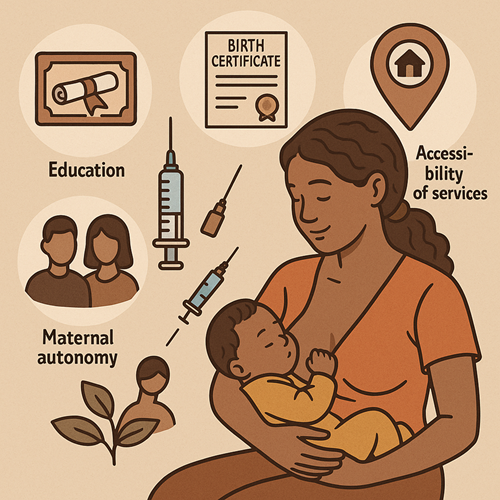Maternal factors influencing complete basic immunization: A Scoping Review
Abstract
Introduction: Immunization is one of the most effective public health interventions to prevent infectious diseases in children. However, achieving complete basic immunization coverage remains a global challenge, particularly in low- and middle-income countries. Maternal factors play a crucial role in determining whether children receive complete immunization. Understanding these factors is essential to inform strategies for improving immunization coverage.
Methods: This scoping review followed the PRISMA-ScR framework to map existing evidence on maternal determinants of complete basic immunization. A systematic search was conducted in electronic databases such as PubMed, Scopus, and Google Scholar, covering publications between 2010 and 2025. Inclusion criteria were peer-reviewed studies addressing maternal characteristics related to childhood immunization completion. Data were extracted and categorized thematically.
Results: The reviewed studies revealed several maternal factors influencing complete immunization. These included maternal education, knowledge and awareness of immunization benefits, socioeconomic status, access to health facilities, and household decision-making autonomy. Maternal age, parity, and antenatal care attendance also showed significant associations with immunization completion. The identified barriers included limited health literacy, cultural beliefs, and logistical challenges such as distance to health services.
Conclusion: Maternal factors are central determinants in achieving complete basic immunization. Strategies to increase coverage should prioritize maternal education, empowerment, and accessibility to health services. Strengthening maternal involvement in child health programs can significantly improve immunization rates and reduce preventable childhood morbidity and mortality.
Downloads
References
Ali, N. and Hassan, R. (2016) ‘Sexual assertiveness and its influence on contraceptive use among married women’, Reproductive Health, 13(1), pp. 55–63. doi: https://dx.doi.org/10.1186/s12978-016-0152-7.
Asefa, H. et al. (2024) ‘Immunization agenda 2030: A global strategy to leave no one behind’, Vaccine, 42(6), pp. S5–S14. doi: https://dx.doi.org/10.1016/j.vaccine.2022.11.042.
Brown, L., Taylor, M. and Wilson, A. (2024) ‘Sexual assertiveness skills as predictors of safe sex practices’, Australian and New Zealand Journal of Public Health, 48(1), pp. 88–95. doi: https://dx.doi.org/10.1111/1753-6405.13422.
Gonzalez, R., Martinez, L. and Perez, D. (2020) ‘Group-based sexual assertiveness training and women’s empowerment’, Women & Health, 60(9), pp. 1015–1030. doi: https://dx.doi.org/10.1080/03630242.2020.1767773.
Hashemi, L. et al. (2024) ‘Migration and infant immunization timeliness in New Zealand: Evidence from the Growing Up in New Zealand study’, Vaccine, 42(9), pp. 2229–2238. doi: https://dx.doi.org/10.1016/j.vaccine.2024.02.053.
Johnson, A., Miller, K. and Roberts, T. (2011) ‘The effectiveness of sexual assertiveness training in young women’, Journal of Women’s Health, 20(4), pp. 455–462. doi: https://dx.doi.org/10.1016/j.jwh.2011.03.005.
Kim, Hyeongsu et al. (2013) ‘Factors Affecting Diabetic Screening Behavior of Korean Adults: A Multilevel Analysis’, Asian Nursing Research, 7(2), pp. 67–73. doi: https://dx.doi.org/10.1016/j.anr.2013.04.002.
Landim, A. S. et al. (2024) ‘How do cultural factors influence the attitudes of human populations protecting fauna? A systematic review’, Journal for Nature Conservation, 79, p. 126605. doi: https://dx.doi.org/10.1016/j.jnc.2024.126605.
Lin, Z. et al. (2025) ‘Pentavalent rotavirus vaccine effectiveness among children in Shenzhen, China: A population-based test-negative design with directed acyclic graphs bias adjustment’, Infectious Medicine, 4(3), p. 100201. doi: https://dx.doi.org/10.1016/j.imj.2025.100201.
Lopez, M., Garcia, R. and Alvarez, J. (2015) ‘Enhancing sexual health through assertiveness training: a randomized controlled trial’, Sexual and Relationship Therapy, 30(3), pp. 221–235. doi: https://dx.doi.org/10.1080/14681994.2015.1024901.
Mbunge, E. et al. (2024) ‘Determinants of under-five mortality in Zimbabwe: Evidence from the 2015–2016 Zimbabwe demographic Health Survey data’, Women and Children Nursing, 2(1), pp. 1–8. doi: https://dx.doi.org/10.1016/j.wcn.2024.02.001.
Mohammed, O., Senoo-Dogbey, V. E. and Ampong Adjei, C. (2025) ‘Hepatitis B virus immunoprophylaxis for newborns of rural women living with hepatitis B virus infection: The moderating role of knowledge, perceived susceptibility and severity’, Clinical Epidemiology and Global Health, 33, p. 102029. doi: https://dx.doi.org/10.1016/j.cegh.2025.102029.
Mohammed, Y. et al. (2024) ‘Exploring the landscape of routine immunization in Nigeria: A scoping review of barriers and facilitators’, Vaccine: X, 20, p. 100563. doi: https://dx.doi.org/10.1016/j.jvacx.2024.100563.
Pasadyn, F., Mamo, N. and Caplan, A. (2025) ‘Battling measles: Shifting strategies to meet emerging challenges and inequities’, Ethics, Medicine and Public Health, 33, p. 101047. doi: https://dx.doi.org/10.1016/j.jemep.2025.101047.
Patel, S. and Singh, R. (2022) ‘Maternal assertiveness and reproductive health practices’, Journal of Family and Reproductive Health, 16(3), pp. 143–150. doi: https://dx.doi.org/10.18502/jfrh.v16i3.9876.
Prakash, R. et al. (2025) ‘Preventing vaccine drop-outs: Geographic and system-level barriers to full immunization coverage among children in Uttar Pradesh, India’, Vaccine: X, 23, p. 100613. doi: https://dx.doi.org/10.1016/j.jvacx.2025.100613.
Pringle, W. et al. (2024) ‘“I try to take all the time needed, even if i do not have it!”: Knowledge, attitudes, practices of perinatal care providers in canada about vaccination’, Vaccine: X, 18, p. 100490. doi: https://dx.doi.org/10.1016/j.jvacx.2024.100490.
Rahman, F. and Dewi, S. (2018) ‘The effect of sexual assertiveness training on prevention of risky sexual behavior’, Indonesian Journal of Public Health, 13(2), pp. 112–120. doi: https://dx.doi.org/10.20473/ijph.v13i2.2018.112-120.
Rios Casas, F. et al. (2024) ‘Creating the vaccination improvement potential index’, Heliyon, 10(14), p. e34906. doi: https://dx.doi.org/10.1016/j.heliyon.2024.e34906.
Robins, A. J., Jenkinson, B. and Kearney, L. (2025) ‘Navigating weight stigma: An integrative review of midwives’ knowledge, attitudes and beliefs about caring for larger-bodied women’, Midwifery, 147, p. 104444. doi: https://dx.doi.org/10.1016/j.midw.2025.104444.
Shedlock, K. E. et al. (2025) ‘Factors Influencing Parental Decisions on Respiratory Syncytial Virus Immunoprophylaxis’, The Journal of Pediatrics: Clinical Practice, 17, p. 200153. doi: https://dx.doi.org/10.1016/j.jpedcp.2025.200153.
Silaen, M. et al. (2025) ‘Health and socio-economic factors as determinants of antenatal care service access in Indonesia’, Clinical Epidemiology and Global Health, 33, p. 102010. doi: https://dx.doi.org/10.1016/j.cegh.2025.102010.
Sinumvayo, J. P. et al. (2024) ‘Vaccination and vaccine-preventable diseases in Africa’, Scientific African, 24, p. e02199. doi: https://dx.doi.org/10.1016/j.sciaf.2024.e02199.
Sinuraya, R. K. et al. (2024) ‘Comprehensive childhood vaccination and its determinants: Insights from the Indonesia Family Life Survey (IFLS)’, Journal of Infection and Public Health, 17(3), pp. 509–517. doi: https://dx.doi.org/10.1016/j.jiph.2024.01.007.
Smith, J., Evans, P. and Carter, L. (2019) ‘Assertiveness in intimate relationships: implications for sexual health’, International Journal of Sexual Health, 31(4), pp. 350–362. doi: https://dx.doi.org/10.1080/19317611.2019.1622347.
Suffel, A. M. et al. (2025) ‘The association of maternal mental health with vaccination coverage and timeliness in early childhood – A historical cohort study in England using electronic health records’, Vaccine, 43, p. 126529. doi: https://dx.doi.org/10.1016/j.vaccine.2024.126529.
Tanner, A. E. et al. (2017) ‘Adolescent to Adult HIV Health Care Transition From the Perspective of Adult Providers in the United States’, Journal of Adolescent Health, 61(4), pp. 434–439. doi: https://dx.doi.org/10.1016/j.jadohealth.2017.05.011.
Wariri, O. et al. (2025) ‘Multi-level determinants of timely routine childhood vaccinations in The Gambia: Findings from a nationwide analysis’, Vaccine, 43, p. 126500. doi: https://dx.doi.org/10.1016/j.vaccine.2024.126500.
Yau, J. H.-Y. et al. (2024) ‘Effectiveness of community-based participatory research (CBPR) interventions on mental health outcomes: A systematic review’, Social Science & Medicine, 363, p. 117491. doi: https://dx.doi.org/10.1016/j.socscimed.2024.117491.
Yusuf, M. et al. (2025) ‘Measles vaccination dropout and its associated factors among children aged 15-23 months in Qardho district, Northeastern Somalia: A community-based cross-sectional study’, Global Pediatrics, 13, p. 100267. doi: https://dx.doi.org/10.1016/j.gpeds.2025.100267.

Copyright (c) 2025 Hatijar Hatijar, Risna Ayu Rahmadani, Asridawati Akib

This work is licensed under a Creative Commons Attribution 4.0 International License.




2.png)
1.png)
1.png)










